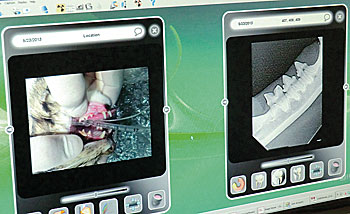Misconception #1: Fluffy’s appetite is great and her teeth look ok, so I don’t need to brush her teeth.
Unlike humans, animals instinctively hide their weakness and signs of illness. This is a useful survival strategy for wild animals but, as a result, we often miss the subtle clues that our companion animals are sick or in pain. Obviously, not eating is not a good survival strategy! This would only be a sign observed with very severe dental disease. It is a good idea to visually inspect your pets mouth on a regular basis. However, we can’t rely on our eyes completely since dental disease only affects their health and quality of life when it is below the gum line.
Misconception #2: Marley hates it when I try to brush his teeth.

Misconception #3: Princess gets her teeth brushed and cleaned by her groomer every month so I don’t need to do anything else for her teeth.
Brushing once a month or once every 6 weeks at a grooming appointment cannot replace regular daily brushing. Pets have very similar oral anatomy and physiology as people and, just like us, they should have their teeth brushed every day.
Misconception #4: Anesthesia for a professional dental cleaning is scary and risky, especially since Rover is getting older.
When done properly by your veterinarian and trained veterinary technicians, there is very low risk for anesthetic complications during a routine dental procedure. A discussion with your veterinarian prior to any anesthetic procedure is necessary to understand the process and proper precautions to ensure safety. Performing a thorough pre-anesthetic exam and blood test is always recommended to identify any unusual risks prior to the procedure. The low risk of anesthesia must be considered in the face of the certain risk of untreated dental disease which will always progress over time and decrease your pets quality of life.
Misconception #5: I can get Bobo’s teeth cleaned without anesthesia–it’s safer and cheaper!
If the thought of a root canal or just stepping foot into your dentist’s office gives you a rapid heartbeat, how do you think your pet would feel in similar circumstance without the benefit anesthesia? Now imagine trying to have your pet hold still while sharp instruments are used to clean their teeth…(and you thought the tooth brushing was hard!)
As a matter of fact, the use of any sharp dental instruments to scale teeth without the supervision of a veterinarian is illegal in the state of California. Check out this link for details: http://www.vmb.ca.gov/laws_regs/dental.shtml — This law was put into place because it is considered inhumane and negligent to practice dentistry on an animal without anesthesia and the supervision of a veterinarian.
Misconception #6: I barely have the time and energy to brush my own teeth, let alone my cat’s teeth!
Home dental care has many different aspects. Nothing replaces tooth brushing…it is your best investment in preventative dental care. However, there is a fantastic array of new dental products that will help round out your pet’s home dental routine. Check out the Veterinary Oral Health Council’s website (www.vohc.org) for a list of products designed to help aid in home dental care. You can rest assured that if the product makes it on this list, it has proven to be safe and effective.
Still unsure what to do about your cat or dog’s teeth? Look for further guidance and techniques in tooth brushing by watching YouTube videos or reading through a detailed guideline from Capitola Veterinary Hospital found here: https://www.dropbox.com/s/tonqb5mds0jzlfl/Home%20Dental%20Care.pdf. Ask your veterinarian for guidance and get set up with the proper equipment to get started … it may be fun!
Happy tooth brushing!
•••
Contact Dr. Katie Volat or Dr. River May at the Capitola Veterinary Hospital: Capvet1@gmail.com